Zoo Tycoon Preview
We take a long look at Microsoft's upcoming zoo-management strategy game.
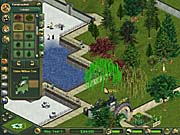
Tycoon simulation-style games, such as Railroad Tycoon, Airline Tycoon, Golf Resort Tycoon, and RollerCoaster Tycoon, test your mettle for juggling a great deal of items and situations, finding you manufacturing, managing, and delegating with the best of them, running transportation organizations and operating theme parks. But seldom do these mock-world scenarios put you in charge of all those details, plus give you the added responsibility of tending to living creatures (besides humans). All good ideas have their day, and Blue Fang Games has taken the simulation principle one step further and tossed animals in the mix in Zoo Tycoon.
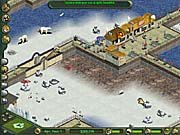
Zoo Tycoon's premise is straightforward enough: A zoo-themed strategy game in which you balance the delicate weights of profit with the well being of living creatures to meet your end goal of building and maintaining a successful zoo. But you'll realize how easy you had it building trains, airlines, roller coasters, and theme parks once you face the task of tending to a giraffe who doesn't like his mate or making saltwater crocodile number two--who doesn't like his water lily--happy, and all the while, patrons are screaming for more trash cans and complaining about the admission price.
GameSpot got a chance to take a mid-development version of Zoo Tycoon for a test drive and realized pretty quickly that it's turning out to be a clever, good-looking product that is not so much the niche game we thought it might be when we first heard about it. We asked Blue Fang's president, Hank Howie, what type of gamer would play this game. "We've found that Zoo Tycoon appeals to both fans of tycoon-style games as well as those who simply love animals," said Howie. "Tycoon fans will enjoy the aspects of building, managing, and maintaining their zoos while making decisions that result in economic profit. However, Zoo Tycoon offers a new aspect of tycoon gaming, as players must anticipate how animals will respond to individual actions. We've also seen players with no tycoon game experience appreciate Zoo Tycoon because of their love for animals...The overall variety, ease of use, and flexible nature of Zoo Tycoon make it appealing to a very broad audience."
There are two ways to play Zoo Tycoon: free play and scenario. Both of these modes seem to offer an enormous amount of gameplay, even at this early stage. Scenarios are a smart way to start, as the first few levels in this mode offer quick and painless tutorials that launch you into what is fairly intuitive gameplay to begin with. From the basic skills you learn in the Smallsville Zoos 1 and 2 tutorials, you can go directly into free play with little or no problem. Free play is a whole other ballpark, giving you free range over small to large zoos and the freedom to set your starting budget accordingly, up to $500,000. This mode has very few rules. We took the path of least resistance and most guidance and started with the scenarios.
If You Build It, They Will Come

The Smallsville tutorials are the first levels within scenario mode, but you don't have to play them to get started in scenarios. We tried them out and found them to be very simplistic, yet effective and fast-moving enough that you don't feel like you've wasted gameplay time learning the rules of the road. You start the first tutorial with a generous $100,000, and the tasks you learn here are simple: create an exhibit, adopt a Bengal tiger, hire one zookeeper, purchase 15 concrete path structures, purchase one food stand, and purchase one drink stand. After you place all these items successfully, you can move on. The second tutorial has you hiring staff and beginning to think about your customers' needs, such as rest rooms, a greater number of concession stands, cleanliness, and amusements. You also start to think about your animals' needs and figure out how to consult with species-specific zookeepers--in this case, about building a savannah exhibit.
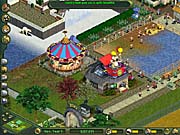
The tutorials do well to acquaint you with the fairly self-explanatory icons and logical game interface. The main and most frequently used buttons are on the left side of the screen, including construction, buying objects, adopting animals, and hiring staff. Buttons for undoing your last action, clearing objects, a message list logging all of the actions you've been alerted to, research and conservation, scenario info, and game options are right below.
Along the bottom of the screen, you'll find a park map that you can use to quickly jump to certain areas of the zoo; a date space, which you'll need for timed missions; a bank space to track your money; a zoo status bar that tells you how your zoo is doing, financially and popularity-wise; and two meters for animal and guest happiness levels. You can also track your exhibits and your staff from this space.
From the tutorial, we went to an intermediate scenario: Inner City Zoo. The starting budget was a grim $25,000 as compared with our hefty tutorial bank, and the objectives were to build, in 12 months' time, a zoo with a good rating of 55, one that had at least 100 guests with a happiness level of 80, with at least six different types of animals and a happiness rating of 55.
Housing six types of animals is a tough hand to play with a limited $25,000, so we had to choose carefully, especially considering that rest rooms, concessions, and other amusements--like a reptile house, aviary, or Japanese garden--are necessary too. The animals range from emperor penguins and wildebeest to giraffes and elephants, and there are about 40 species total you can choose from, with more becoming available to you as you play and earn more money. We started big and built a large chain-link fence for giraffes, placing them inside once it was finished. Then for the exhibit we hired a zookeeper, who would inform us of the animals' needs. If the animals like the foliage and terrain that you add, a green smiley face appears over their heads. If they don't like your work, a red angry face appears, and you have to adjust. After the right percentage of savannah grass and the perfect trees were placed, a good chunk of the budget had gone to the giraffe, and it was time to add concessions and jack up the price of admission to generate some cash flow.
The intermediate scenario level was greatly amusing and much more difficult than expected. The balance of keeping animals and patrons happy was tenuous, at best, and we failed our mission several times before finding that equilibrium. Other scenarios involve building environment-specific zoos, such as seaside and Forest, and the challenging Revitalize Burkitsville Zoo level, in which you rehabilitate a wasted zoo. Having worked under the clear directives found in the scenario mode, we felt ready to leave the nest and venture into Zoo Tycoon world free-form.
Born Free Range
It was easier to focus on building excellent animal exhibits in the scenario mode. Even when the objective of having at least 100 guests came into play, you could pretty much count on that many showing up and being relatively happy as long as there was something to do. But free play was much more difficult. You have three options from the start: a small, medium, or large basic park. We went with large and gave ourselves a generous starting budget of $500,000--the maximum limit.
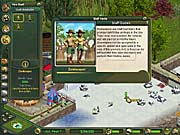
There are so many decisions to make from the get-go that starting a free play level can be overwhelming. Focus is necessary to build a good park. But one theme kept appearing over and over again: People needed food, they were thirsty, they thought the park was dirty, they needed to use the rest room, and they didn't care for the admission price. We spent so much time satisfying peoples' needs--or trying to--that the animals we'd managed to purchase and house were getting minimal care at best. The Zoo board had threatened to shut us down for lousy animal conditions over and over again, and the chimpanzees kept escaping while we were placing garbage cans around the environment. This is not a game criticism; this is a testament to the many levels of organization you must be able to manage to be successful with Zoo Tycoon. But then came a plan. If only we could anticipate the customers' needs up front, satisfy those before they ask, and then spend all of our time with animal and habitat construction, we'd be set.
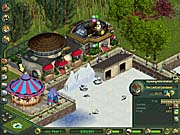
We started round three of our large, $500,000-budget free play zoo with a food court, replete with all the rest rooms, hot dog stands, trash cans, and picnic tables a family of four could want. We loaded the entrance to this glutton's nest with gift shops and large, garish attractions such as elephant rides and carousels. Sparing no expense, every corner had a fountain or a duck pond, and we threw in an animal theater and petting zoo for good measure. We were totally prepared to meet the expectations of the crowd and subsequently focus on animal exhibits. Then the people started arriving, and while they found the admission price to be "a great bargain," the next sea of comments began, like finding the zoo "to be quite ugly." Here's to the game's AI; it looks like Blue Fang captured human nature to an exacting degree.
Zoo Tycoon is shaping up to be a solid sim game, with terrific little touches that make all the difference in the world. It's great that you can allot a certain amount of money each month to marketing or that a fresh coat of paint on the hot dog stand may help sell more dogs. Tracking the sales and increasing the prices of items at each stand and vending station is a lifesaver, literally. Also, research and conservation projects such as a rock cave exhibit and the ever-popular insect house engage the theme--you just might learn something.
We experienced a bit of slowdown onscreen in free play mode. But it was an early build, and the screen loaded with well more than 100 people and about 20 buildings and five exhibits to boot. But the animal and human animations remained impressive. The cameras could sometimes be a little tough to maneuver, and some spaces between structures were hard to get to, but hopefully this will be ironed out in the final version.
All in all, Zoo Tycoon is very clever and brings all of the fun of Tycoon-style games to the animal kingdom, adding the new element of caring for living, breathing, and often unpredictable creatures. Zoo Tycoon is scheduled to ship this fall.
Got a news tip or want to contact us directly? Email news@gamespot.com
Join the conversation